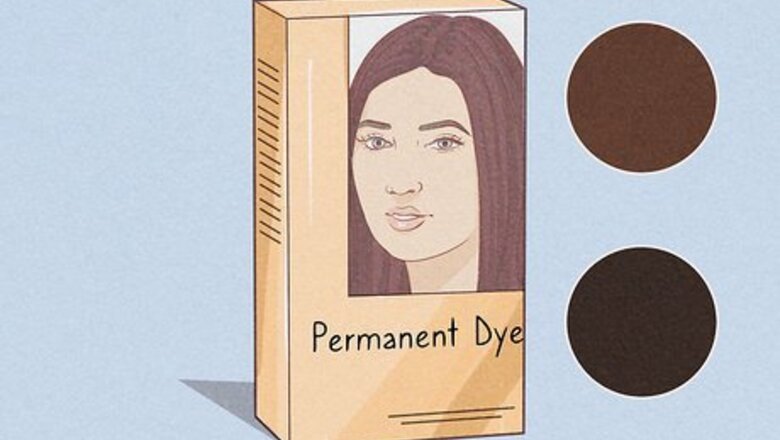
views
Using Hair Dye
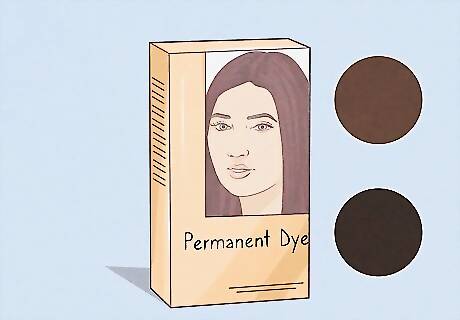
Choose a permanent dye that’s within 2 shades of your natural color. For the best results, don’t try to make too drastic of a change. If your hair isn’t naturally black, dyeing your hair that dark can end up looking really severe. However, if your hair is already dark, this can be a very effective method for hiding your greys. You can also try using a dark brown or brownish black dye instead of pure black. Semi-permanent dyes aren’t as effective at covering up greys, and they can even stain your grey hair a yellowish shade. They can be helpful for helping to blend your greys with your natural hair color, however. Look for a foam formula if you have very thick hair. It will help coat your hair more evenly without dripping everywhere.
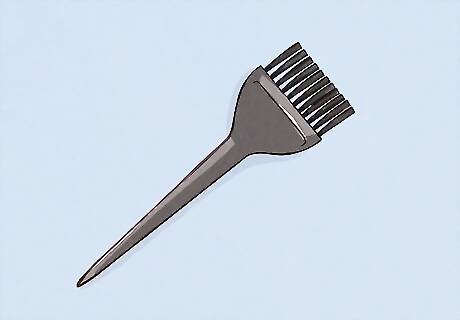
Buy a brush if the kit you choose doesn't come with one. A brush is much more effective at getting down into your roots than the nozzle on a bottle. If you pick out a dye kit that doesn’t have a brush, pick one up while you’re shopping. You can find brushes intended for dye, but you can also use a regular paintbrush or craft brush if you want. You can use a foam or a bristle style brush.
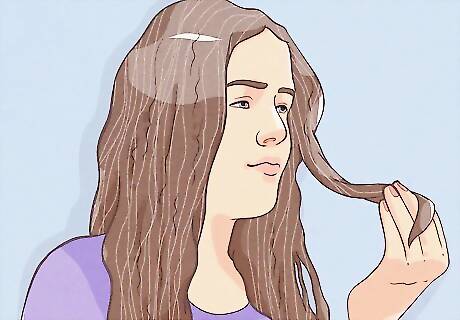
Start with unwashed, dry hair. When you apply permanent dye, it’s best to start with dry hair. Also, if you can, try to dye it 2-3 days after the last time you washed it. The natural oils will help protect your scalp from the chemicals in the dye. Some dyes may have other recommendations, so be sure to read the instructions carefully.
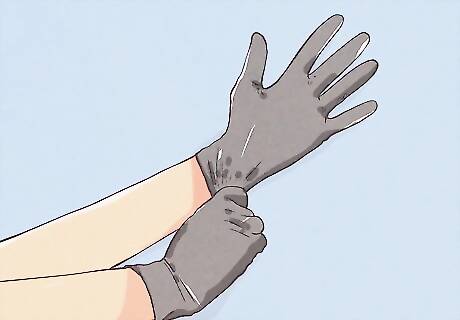
Put on old clothes and gloves, and put garbage bags on the floor. Dye can get messy, so protect your skin, clothes, and the floor around you. Wear old clothes and put on the plastic gloves that came with your dye. Also, you may want to lay garbage bags on the floor around your work area. You can use a towel if you want, but the dye might seep through and stain your floor, so plastic works best. Consider wearing a robe or a button-down shirt. That way, when it’s time to rinse, you won’t have to pull your shirt over your head. Another good option is to wear a hairdresser’s cape, which you can purchase online or from a beauty supply store.
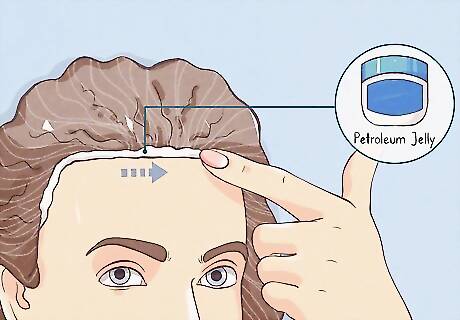
Rub petroleum jelly around your hairline so the dye doesn’t stain your skin. Use a generous amount, all the way around your hairline and the tops of your ears. This will create a barrier around your hairline to prevent staining. You can also use moisturizer or oil.
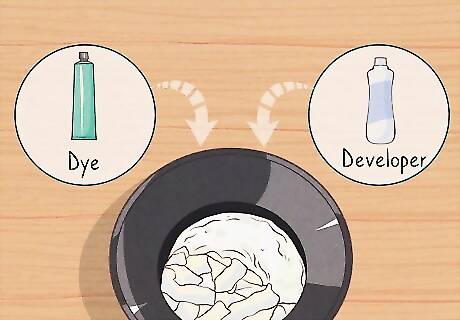
Mix the dye and developer in a bowl. Typically, dye comes with a bottle of color and a separate bottle of developer, and you mix the 2. Read the package instructions carefully, then pour the contents of both bottles into a bowl and stir them together with a plastic spoon. The instructions may direct you to mix the ingredients in an applicator bottle, but since you’re using a brush, it will be easier to pour them into a bowl and stir them together.

Do a strand test. Before you commit to dyeing any visible greys, test the color on an inconspicuous spot, like just above your ear—just make sure you choose a spot with grey hair. Apply the color to the strand and leave it on for about half the time recommended on the box. Then, wipe the dye away with a wet cloth and check the color. If you experience any redness, itching, or irritation, rinse the strand right away and do not use the remainder of the dye. The color should be a little lighter than the result you’re going for, but the shade should be close to what you’re expecting. If it’s dramatically different, you may need to choose a different color dye.
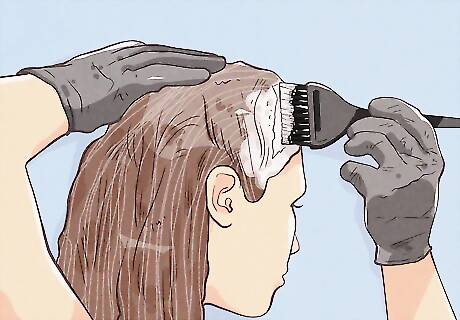
Apply the dye to your grey hair with the brush. Dip the tip of the brush in the bowl of hair dye, then paint the dye onto your hair, starting at the front of your hair. Focus mainly on your roots if your greys are just starting to show, or apply the dye all the way down the length of your hair if it’s already totally grey. Use the tip of a comb or your hair dyeing brush to part your hair and apply the dye in sections. That way, you won’t miss any greys. If you're concerned the dye color won't match your natural color, apply the color all over your hair.
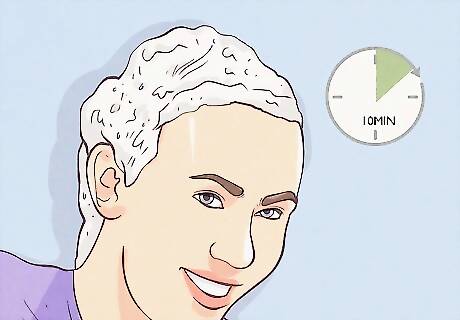
Leave the dye on according to the package instructions. Use the results of your strand test and the package instructions to help you know how long to leave your dye on. Some products may work in as little as 10 minutes, while others may take longer. If your strand test produced really dark results in half the time, you’ll know you don’t need to leave the dye on the entire time, for instance.
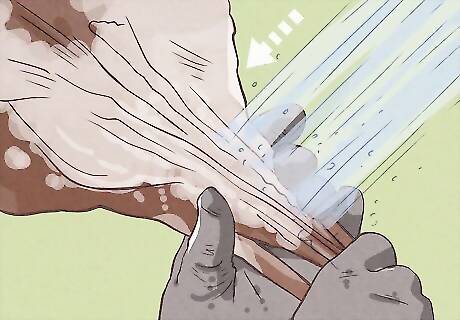
Rinse the dye out thoroughly and condition your hair. Once you’ve waited the recommended time, rinse out your hair with cool water. When the water runs clear, apply a deep conditioner to your hair to help soothe it from any damage caused by the dye. Most commercial dye kits come with conditioner included. If your dye kit didn’t include a conditioner, use one that’s formulated for color-treated hair if possible.

Touch up only your roots as needed. When your roots start to show, you’ll probably want to dye them again. This time, though, don't apply the dye to all of your hair, even if you dyed it all the first time. That can be very damaging to your hair over time. Instead, about 5 minutes before the time is up, comb the dye through the rest of your hair, then rinse and condition as normal. You may need to touch up your roots every 4-5 weeks, depending on your regrowth.
Dyeing with Henna and Indigo
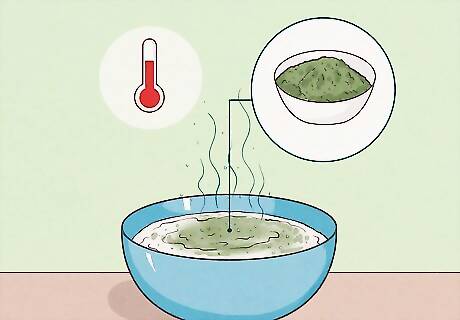
Mix hot water and henna powder in a plastic bowl. For long hair, mix 1–2 US tbsp (15–30 mL) of water and 1 cup (200 g) of henna together in a plastic bowl. Do not use a metal bowl, as it may react with the henna. Stir the mixture with a plastic spoon until there are no lumps and the paste is about the consistency of pancake batter or yogurt. You may need more or less liquid than is recommended, so have extra on hand just in case. You can also use brewed coffee or hot tea, which may produce a darker hue. Purchase henna powder at select beauty shops or order it online. You won't need all of the mixture if your hair is very short or you're only covering your roots.
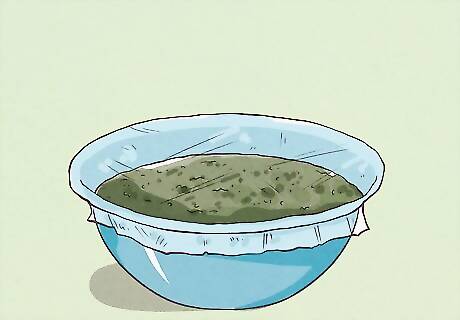
Cover the mixture with plastic wrap and let it sit for 4-6 hours. Since you’re working with a natural product, the reaction times take longer than if you were using chemicals. Cover the bowl tightly with plastic wrap, then wait 4-6 hours for the henna to oxidize, or leave it out overnight. Store the mixture at room temperature.

Stir in 1 cup (200 g) of indigo powder. After the henna has had several hours to oxidize, add in your indigo powder. To get black dye, use equal amounts of indigo and henna powder. If you wanted a slightly lighter or redder color, use more henna and less indigo. Tip: Some people have better results by breaking this into 2 separate applications. First, make a paste from henna powder and water, then apply the mixture to your hair and leave it on for 2 hours. Rinse it out and dry your hair, then apply a paste made from the indigo powder. Leave that on for another 2 hours, then wash it out with a mild shampoo.
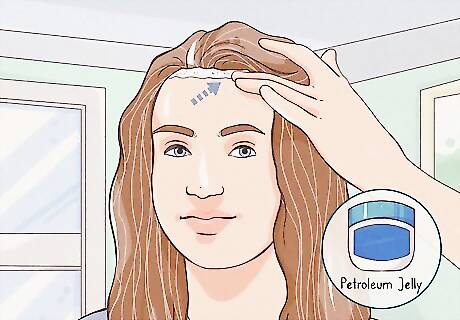
Rub petroleum jelly around your hairline so the dye doesn’t stain your skin. Petroleum jelly forms a barrier, so if you get some of the henna and indigo mixture on your skin, it’s less likely to stain. Use your finger or a soft cloth to rub a generous amount all around your hairline and the tops of your ears. Moisturizer, oil, or lip balm can all work if you don’t have petroleum jelly on hand.

Protect your skin, clothes, and the floor where you'll be working. Henna and indigo can stain your skin, your clothes, and the floor around you if it drips. To make cleanup easy, wear clothes that can get stained, put on a pair of thin latex gloves, and place trash bags on the floor where you’ll be working. You can use towels on the floor, but large drips of dye might soak through and stain the floor. Consider wearing a robe or a button-down shirt so you don’t have to pull your top over your head when it’s time to rinse your hair. You could also cover your clothes with a hairdresser’s cape.
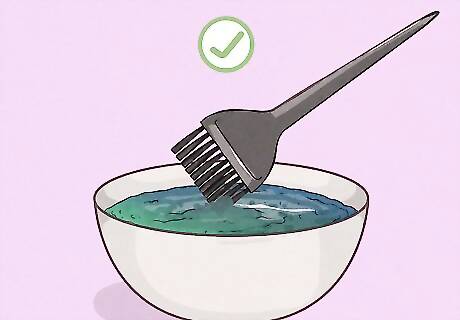
Use a brush to apply the henna and indigo mixture to clean, dry hair. As you’re starting, focus on your roots, especially at the front of your head and around your temples, where greys tend to show the clearest. Once you’ve completely covered your greys, spread the remaining dye through the rest of your hair. You can use any type of paintbrush for this, from a bristled brush to a foam craft brush. Using a brush will make it easier to get the dye all the way down into your roots, and the color will typically be more evenly spread throughout your hair.
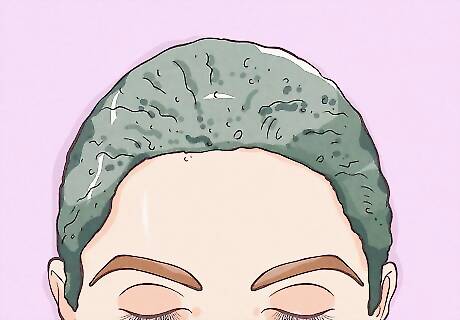
Let the mixture sit on your hair for 2-2 1/2 hours. It takes time for the dye to fully soak into your hair, so you’ll have to be patient for this part. Find somewhere comfortable, then put on a movie, chat with a friend, or play a game while you wait. Try not to move around too much, since you don’t want to accidentally transfer the dye to anything. Since the dye can stain anything it touches, you may want to cover your hair with a shower cap while you’re waiting.
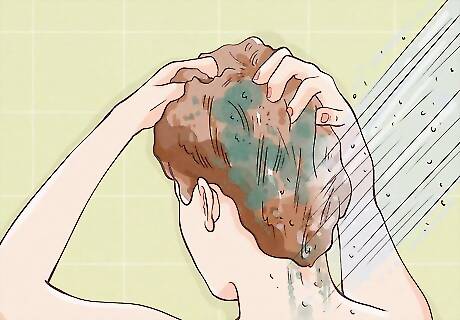
Wash your hair with warm water and mild shampoo, then condition. Once the time is up, you’re ready to rinse! Use a mild shampoo and wash your hair thoroughly. Rinse until the water runs clear, then coat your hair in a conditioner. If you’d like, you can leave the conditioner in for several minutes, then rinse it away as well. Once your hair is dry, it should look healthy and black, with no sign of greys! Most household shampoos are fine, but avoid using clarifying or medicated shampoo to rinse your hair, as they may pull some of the color out of the hair’s cuticle. If you notice a slight green tint, don't worry—it will typically go away in 2-3 days.


















Comments
0 comment